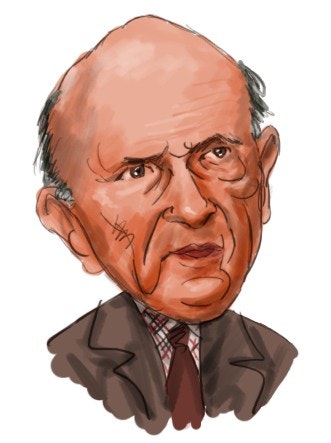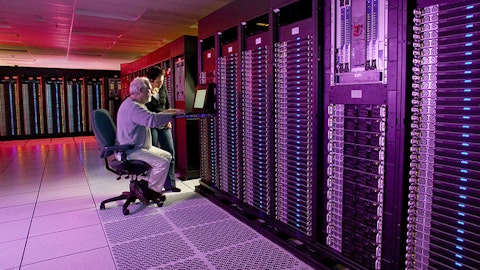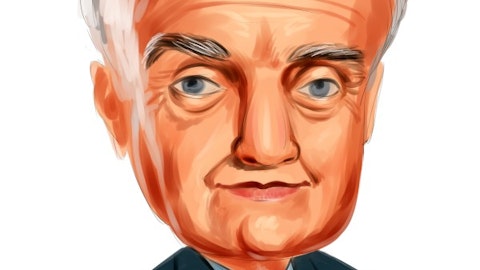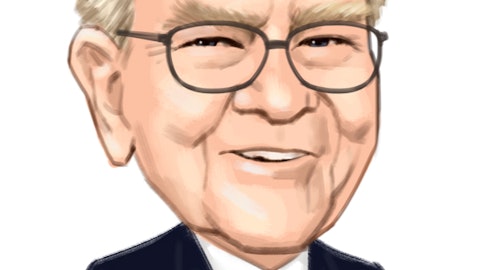In this article, we shared billionaire Julian Robertson’s top 10 stock picks. You can skip our detailed discussion of Robertson’s investment philosophy, his fund’s performance and go directly to Billionaire Julian Robertson’s Top 5 Stock Picks.
The 88-year-old billionaire, Julian Robertson was in the U.S. Navy before working as a stockbroker for Kidder, Peabody & Co., when his family moved to New York. He eventually became the head of the firm’s asset management division. In 1980, Robertson founded Tiger Management with $8 million. Using a long-short strategy and after 16 years of successful investment returns, Tiger Management grew its popularity and attracted more investors, resulting in a $7.2 billion of assets under management by 1996, and a peak of $22 billion two years later.
Robertson’s Tiger Management holds the best hedge fund record in the 1980s up to 1990s. In the year 2000, due to a period of unimpressive performance, Julian Robertson decided to close his fund but he stayed active in the hedge fund business by mentoring and financing future hedge fund managers in exchange for a chunk of their fund management companies. He is considered to be the father of hedge funds after mentoring a group of people that eventually became successful fund managers. Billionaires Chase Coleman, Ole Andreas Halvorsen and Lee Ainslie are some of the former employees of Robertson whom he mentored and are now running their own hedge fund firms. They are called ‘Tiger Cubs’. As of 2021, the legendary Julian Robertson has a net worth of $4.3 billion.
In a CNBC interview last May 2020, Robertson mentioned that interest rates and stock prices will go higher by 2021.
“There’s a very good chance of that happening in through next year, and I’m sort of positioned already. Next year we could have an advance in interest rates to the point where the Fed would begin to slow down a little bit,”.
Robertson has nothing but high praises for the 3 big tech companies he invested in at the time, namely Microsoft, Google, and Facebook. Asked if he’s willing to hold these stocks for a long period, he replied:
“Very definitely. They probably sell on an average somewhere under a 20% premium to the market. That’s not terribly high for the greatest companies in the world.”
By the end of this article you will find out whether Robertson is still invested in these tech giants.
Robertson’s Optimism on Zuckerberg and Facebook
Regarding Facebook’s data privacy issues and the regulatory threats to its business model, Robertson said that it is definitely a negative factor for the company, however, he remains optimistic.
“The sheer size I think is definitely a negative factor, but I think, that is simply taken care of in the price of the stock. It wasn’t too long ago when Facebook became public. These were young people and what they’ve accumulated and done in a short period of time is just amazing. They’ve been criticized tremendously because they haven’t been probably as efficient in secrecy as they should be, but they certainly apologized for it and certainly, they’re good people. Mark Zuckerberg (CEO, FB) poured money into New Jersey’s Charter Schools and really helped get that whole area underway. I’m a big fan of a lot of these people that are in these kinds of companies.”
Robertson was confident that Mark Zuckerberg is not too young or too inexperienced to lead Facebook. He is optimistic that the CEO has the capability to take the company to higher levels.
Julian Robertson on the North American Free Trade Agreement (NAFTA) and Air Canada
According to the Official website of the Department of Homeland Security, the North American Free Trade Agreement (NAFTA) established a free-trade zone in North America. NAFTA was signed in 1992 by Canada, Mexico, and the United States and took effect on Jan. 1, 1994.
“I think there will be some breakdowns in NAFTA but I don’t think that’s the end of the world. On the other hand, I think Air Canada is not an expensive stock, and it’s a beautifully run company. In fact, I think its cashflow is going to be around 30%.”
Talking about the banking industry, Robertson said that the banks in America are very reasonable in terms of potential returns.
“I think we see them creeping up on huge cash flow yields next year and thereafter. I think the banks are in terrific shape, and I love JP Morgan, and Bank of America,– that’s where my money is. There are other(banks) I like and I’ll probably put some names like Goldman and Morgan Stanley. I would call them investment banks, but I certainly would call them attractive banks.”
On the other hand, when a company’s expansion has gone on for more than 10 years and stock prices have gone up so much, the biggest question that most people ask is that how much more can it keep going? Here’s how Julian Robertson responded to that:
“You have to look at the ones that are reasonable in relation to their growth and I think these so-called things, the Microsoft, and the ones we’ve been talking about, have growth rates that allow them multiples.”

Interest Rates and Stock Picks from the Legendary Investor, Julian Robertson
According to the veteran fund manager, if interest rates become very high, it can technically be a threat not only to the tech companies but to the economy as a whole.
“I think it’s somewhat of a threat to the economy.– But I think the likelihood is that they (interest rates) will not go wildly up, and we’ll be able to live through this.”
On a final note, the billionaire investor, Julian Robertson was asked what stock would he tell his grandchildren to invest in, he said,
“It would be Facebook, it would be Bank of America (BAC), and it would certainly be JP Morgan (JPM). Also probably Citigroup (C) which is reasonably priced, but the first three would be the things that would be very attractive. I’d buy the airlines in addition to these other things. There is a lot to choose from and I still feel pretty good about things. The Federal Reserve has been smart to raise interest rates. He’s going to continue to raise them in the next 6 or 7 months, and I think we look pretty good.”
Let’s now examine the top 10 stock picks of the legendary billionaire, Julian Robertson, and see how they are currently performing today.
10. Controladora Vuela Compañía de Aviación, S.A.B. de C.V. (NYSE: VLRS)
Value: $12,298,000
Change in Position Size: 0%
Percent of Julian Robertson’s 13F Portfolio: 2.8%
Ranking 10th on the list of Julian Robertson’s Top 10 Stock Picks is Controladora Vuela Compañía de Aviación (VLRS). Mexico-based VLRS is a low cost airline company that is the 2nd largest airline in the country. The company offers domestic and international flights within Mexico, the United States and Central America. According to its fourth quarter 2020 results, VLRS’s cash and cash equivalents reached 10.1 billion Mexican Pesos, that equates to 45.6% of its operating revenue for the last 12 months. It also delivered a negative net debt, meaning, it had a positive net cash position.
As of the end of the fourth quarter, 19 hedge funds in Insider Monkey’s database of 887 funds held stakes in VLRS, compared to 9 funds in the third quarter. Teewinot Capital Advisers is the biggest stakeholder in the company, with 6.1 million shares, worth $76 million.
9. Alphabet Inc. (NASDAQ: GOOG)
Value: $24,158,000
Change in Position Size: 1%
Percent of Julian Robertson’s 13F Portfolio: 5.5%
Google’s mother company plunged 3.26% on February 25, 2021 as it closed at $2,031.36 per share from its $2,095.17 share price at the closing of February 24th. Alphabet Inc. currently has a $1.38 trillion market capitalization and delivered a decent 53.60% return in the past 12 months.
According to our database, the number of hedge funds with long GOOG positions increased during the fourth quarter of 2020. There were 179 hedge funds that held a position in GOOG compared to 162 funds at the end of the third quarter. The biggest stakeholder of the company is billionaire Chris Hohn’s TCI, with shares worth $5.2 billion.
Kinsman Oak Capital Partners, in their Q4 2020 Investor Letter, said that they have a controversial view on Alphabet Inc. (NASDAQ: GOOG) because they view it as a ‘not so expensive’ company.
Here is what Kinsman Oak Capital Partners has to say about Alphabet Inc. in their Q4 2020 investor letter:
“Our view on Alphabet (GOOG) may be somewhat controversial. The bear case for GOOG boils down to antitrust risk and valuation. Our thesis is predicated on the belief that real earnings power, especially for Alphabet, is higher than it appears on the surface. At first glance, Alphabet’s P/E appears to be 30.2x. Adjusting for net cash brings this down to 27.9x. Alphabet’s “Other Bets” segment generates de minimis revenues but reduces operating income by 13%. Adjusting for that (and assigning zero value to a segment that includes Waymo, Nest, and Verily) brings the multiple to 24.7x versus the S&P 500 trading at 22.3x.
Alphabet, at a 10% premium to the S&P 500, is one of the biggest relative value bargains hiding in plain sight we have seen. Alphabet has a much deeper moat, better margin profile, less capex requirements, and faster growth profile than the average company within the index (estimated 18% CAGR for the next two years versus 8% for the S&P 500).
Pushing the envelope, Alphabet’s multiple would be lower than the overall market if the company treated stock-based compensation as dilution and/or if research & development was capitalized instead of expensed. Internally we use a more detailed sum-of-the-parts analysis to more closely approximate intrinsic value. Further, Waymo provides significant upside optionality, especially if you believe Tesla’s “full self driving” technology justifies a large portion of its market cap.
In short, we believe the obfuscated earnings power makes Alphabet appears more expensive than it really is. After adjusting for factors like “Other Bets” in Alphabet’s case or net cash, stock-based compensation, and research and development treatment, it becomes clear that investors are being adequately compensated for the associated antitrust and regulatory risk.”
8. QUALCOMM Incorporated (NASDAQ: QCOM)
Value: $24,908,000
Change in Position Size: 0%
Percent of Julian Robertson’s 13F Portfolio: 5.7%
California-based QUALCOMM Inc.’s field of expertise is in wireless technology. The company offers intellectual property, semiconductors, software and other related services. It also designs and innovates chips specially made for smartphones. With their continuing expansions, QCOM disclosed that they will open a new 5G R&D center in France, with the aim to drive 5G development ‘locally, regionally, and globally’. QCOM’s revenues in the first quarter of 2021 increased 62% to $8.2 billion.
The financial numbers show exceptional growth on a year-over-year basis, as the company capitalized on the strong demand for 5G-enabled smartphones. If we look at the performance of key segments, revenue from the mobile phone chips business climbed 79 percent to $4.22 billion, revenue from the radio frequency chips segment skyrocketed 157 percent to $1.06 billion, and revenue from the automotive chips business rose 44 percent to $212 million. Moreover, the company’s licensing division generated revenue of $1.66 billion, translating to a surge of 18 percent from the year-ago quarter.
Looking forward, Qualcomm expects to report revenue in the range of $7.2 billion and $8 billion for the current quarter, higher than what most analysts predicted.
An analyst at Citi Research on Thursday downgraded Qualcomm following Q3 results. Analyst Christopher Danely cut his ratings for QCOM from “Buy” to “Neutral.” He also trimmed his price target for the stock from $194 per share to $165 per share, saying the 5G upgrade cycle is over and the company may have to deal with lower margins in the future.
With a $508 million stake invested in QUALCOMM, Matrix Capital Management owns 3.3 million shares of the company as of the end of the fourth quarter of 2020. Our database shows that 85 hedge funds held stakes in QCOM as of the end of the fourth quarter, versus the 87 funds in the third quarter.
7. SLM Corporation (NASDAQ: SLM)
Value: $25,519,000
Change in Position Size: 0%
Percent of Julian Robertson’s 13F Portfolio: 5.8%
New Jersey-based SLM Corporation is a consumer banking company with a $6 billion market cap. Commonly known as Sallie Mae, the company’s main business is through offering loans to students in order to help many families pay for educational expenses. The company offers a free online scholarship database that contains information about scholarships and other related materials. Based on SLM’s Q4 2020 results, the company generated a $1.13 or $431 million GAAP net income attributable to common stock, versus the $0.32 or $134 million in 2019.
As of the end of the fourth quarter, there were 19 hedge funds in Insider Monkey’s database that held stakes in SLM Corporation, compared to 22 funds in the third quarter. ValueAct Capital, with 32.2 million shares of SLM, is the biggest stakeholder in the company.
6. Micron Technology, Inc. (NASDAQ: MU)
Value: $33,553,000
Change in Position Size: -2%
Percent of Julian Robertson’s 13F Portfolio: 7.6%
Idaho-based Micron Technology Inc., specializes in producing computer memory and computer data storage. The share price of Micron fell 4.76% this past Thursday as it settled at $88.12 per share, from Wednesday’s closing price of $92.52. The company currently has a $102.2 billion market capitalization and it delivered a 73.92% return in the past 12 months.
As of the end of the fourth quarter, 100 hedge funds in Insider Monkey’s database of 887 funds held stakes in Micron Technology Inc., compared to 79 funds in the third quarter. Arrowstreet Capital is the biggest stakeholder in the company, with 17.5 million shares, worth $1.3 billion.
In their Q4 2020 Investor Letter, Bonsai Partners highlighted a few stocks and Micron Technology Inc (NASDAQ:MU) is one of them. Here is what Bonsai Partners said:
“Micron is a manufacturer of memory semiconductor chips. Micron’s stock appreciated 60.1% during the quarter.
Micron’s shares significantly appreciated this quarter for a couple of reasons. First, and most importantly, the DRAM market appears to have begun its cyclical rebound. As a result, we will likely see higher pricing and profitability through at least the calendar year 2021, hopefully meaningfully longer.
Another (and less meaningful) driver was that semiconductor stocks have become ‘en vogue’ once again. I may not be old, but I’ve been around the sector long enough to know that when generalists start getting excited about a ‘new paradigm’ around semiconductors, it’s time to be wary.
I wouldn’t call Micron overvalued, but I’d certainly say it’s more fairly priced today compared to when we first purchased it a few months ago.”
Click to continue reading and see Billionaire Julian Robertson’s Top 5 Stock Picks.
- George Soros’ Top 10 Stock Picks
- Billionaire Lee Cooperman’s Top 10 Stock Picks
- Warren Buffett’s Top 10 Stock Picks
Disclosure: None. Billionaire Julian Robertson’s Top 10 Stock Picks is originally published on Insider Monkey.





